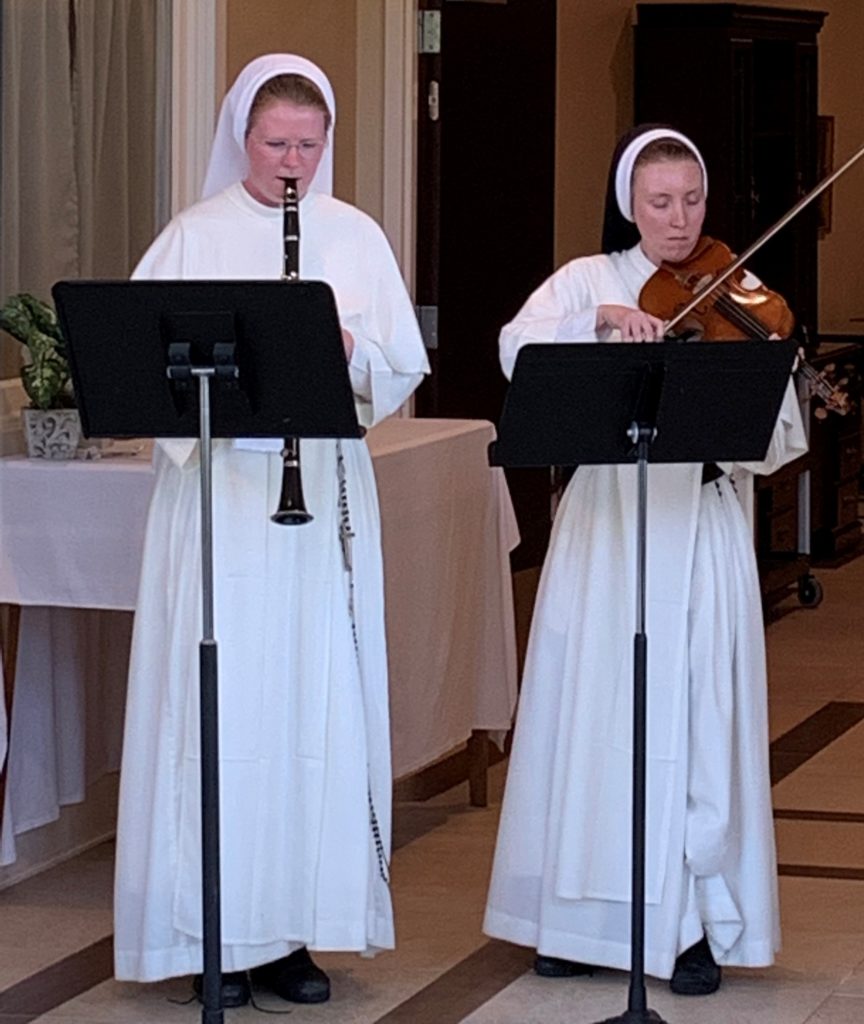How Music Deepens your Prayer Life
Posted on Monday, November 1, 2021
by Sister Mary Ruth, O.P.
Sister Mary Ruth serves as an adjunct professor of music for Aquinas College
How can music deepen our prayer life? How does music interact with the human soul in the Liturgy, when the Holy Spirit uses music to draw the soul closer to God?
Here are some thoughts on this question from three doctors of the Church: St. Thomas Aquinas, St. Hildegard of Bingen, and St. Therese of Lisieux. A Dominican from the thirteenth century, St. Thomas Aquinas saw a beautiful thing as meeting three primary conditions[1]: The first, integritas (completeness) requires that the beautiful thing must not lack anything it needs to be most itself. As St. Thomas puts it, “. . . those things which are impaired are by the very fact ugly.”[2] Consonancia (proportionality), the second condition, requires that the thing of beauty have fitting dimensions, both within itself and with respect to its purpose or end. St. Thomas describes this due proportion as harmony. Lastly, when the beautiful thing fulfills these first two conditions, it radiates a certain splendor through the very immediacy and directness by which it is clearly knowable to the mind of the perceiver. This claritas allows the perceiver to rest in the intelligibility of the beautiful thing. “We call things beautiful when they reveal their ontological “secret,” the invisible spiritual reality of their being as objects of understanding.”[3]
St. Thomas describes these three conditions of beauty in the section of his Summa Theologica about the Trinity when he explains the Second Person of the Trinity, Christ the Son. When liturgical music satisfies these three conditions, it participates in the beauty of Christ, the source of all beauty. Its harmony or consonancia can stir in man a profound longing for the right ordering and harmony that characterized his soul in its state of original innocence. “The fundamental role of beauty for Aquinas . . . is the restoring of order and of an equilibrium. . .”[4]

This restoration of order and equilibrium was of primary interest to Hildegard of Bingen. Abbess, composer, theologian and Doctor of the Church, she was born in 1098 in what is now Germany. From a young age she experienced special perceptions of God’s presence during prayer. At a certain point, the Lord asked her to illustrate her visions and to notate her musical locutions. Within the scope of her holistic medieval world view, she composed music to move the emotions through sensory beauty. In her writings, she revealed her anthropology: man learns of what is interior (spiritual) through what is exterior (physical). As Abbess, Hildegard taught her nuns that their music and chant for the Mass and Divine Office helps their souls regain the harmony lost in original sin. Her concepts of harmony and order extended to all of creation, and allowed her to make an explicit connection between moral harmony and musical harmony.[5] The practice of music on earth, especially in the liturgy, allows Christian souls to participate in the choirs of heaven. In this capacity, music, for Hildegard, functions as an effective symbol that puts a soul in contact with the Reality it symbolizes.
St. Therese of Lisieux claimed St. Cecilia as her “saint of predilection[6]” upon learning that St. Cecilia was not named the patroness of music because of any musical talents that Cecilia may have possessed. Rather, Saint Therese identified St. Cecilia’s effect on souls: to draw them toward the purity and beauty of faith. “Everything in her thrilled me, her abandonment, her limitless confidence that made her capable of virginizing souls . . .”[7] Music can become a distant echo of man’s primordial innocence, awakening a certain nostalgia for higher and heavenly joys in souls “who had never desired any other joys but those of the present life”.[8]
Why this question matters: It can ignite a renewed zeal and fervor for liturgical worship.
This question is full of wonder. Beauty seems to be marked by God’s own way of defying analysis and definition while leveraging tremendous effects on man. Ultimately, the Savior Himself explains it very simply when He says, “When I am lifted up, I will draw all men to myself.”[9] Clearly He refers here to His Crucifixion, His being lifted up on the Cross. If the sense of ‘lifted up’ is expanded to include the meaning of lifting up God’s Name in praise, the reality emerges that as the Church sings in worship of God, present in their midst, God does indeed draw us to Himself. Music in liturgy provides us with the opportunity to praise and thank God, and to dispose ourselves to God’s constant power to draw us to Himself.
[1] Summa Theologica, I. Q39. a8.
[2] St. Thomas Aquinas, Summa Theologica (New York: Benzinger Brothers, Inc., 1947), 201.
[3] Denis McNamara, Catholic Church Architecture and the Spirit of the Liturgy (Mundelein, IL: Hillenbrand Books 2009), 24.
[4] Umberto Eco: The Aesthetics of Thomas Aquinas (Cambridge, MA: Harvard University Press. 1988).
[5] Eidt, Evan. “The person: history and tradition”. CLASS 4A – Hildegard of Bingen: Tuning the Soul to God. https://www.catholicfaithandculture.udallas.edu/the-person-history-and-tradition
[6] St. Therese of Lisieux. Story of a Soul Third Edition. (Washington, D.C.: ICS Publications, 1996), 131.
[7] Ibid.
[8] Ibid.
[9] John 12:32
